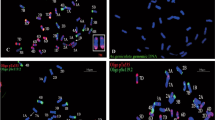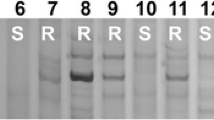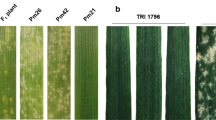Abstract
Powdery mildew (Pm), caused by Blumeria graminis f. sp. tritici (Bgt), is one of the most serious diseases for common wheat in many regions around the world. Seeking for new resistance source is urgently required to meet the challenge of the rapid loss of resistance due to the co-evolution of the pathogen’s virulence. Wheat line 07jian126 (Triticum aestivum L.) is highly resistant to the Pm disease prevailing in Sichuan province of China. Previous study showed that a SSR marker Xbarc183 was linked to the Pm resistance in 07jian126, which might be controlled by a single dominant gene, designated as Pm07J126. In this study, two additional F2 populations were used to confirm the linkage between Pm07J126 and Xbarc183. Furthermore, rye chromatin was detected in 07jian126 by molecular analysis of a rye-specific SCAR marker O5 which co-segregated with Pm07J126. This result indicated that Pm07J126 might originate from rye. The reaction patterns to 21 Bgt isolates and molecular marker analysis implied that Pm07J126 might be different from the known rye-derived Pm genes Pm7, Pm8, Pm17 and PmJZHM2RL. Chromosome observation, molecular marker, and A-PAGE analysis suggested that 07jian126 might be a rye introgression line and neither contain 1RS translocation nor secalins gene. Consequently, 07jian126 could be considered as a valuable resource for Pm resistance development of wheat. Besides, the molecular markers Xbarc183 and O5 are useful in marker-assisted selection of Pm07J126 in wheat breeding programs.




Similar content being viewed by others
References
An DG, Li LH, Li JM, Li HJ, Zhu YG (2006) Introgression of resistance to powdery mildew conferred by chromosome 2R by crossing wheat nullisomic 2D with rye. J Integr Plant Biol 48(7):838–847
Bernhard S, Günter W (1999) Development of simple sequence repeat markers in rye (Secale cereale L.). Genome 42:964–972
Francis HA, Leitch AR, Koebner RMD (1995) Conversion of a RAPD-generated PCR product, containing a novel dispersed repetitive element, into a fast and robust assay for the presence of rye chromatin in wheat. Theor Appl Genet 90:636–642
Frank MY, Huo NX, Karin RD, Yong QG, Luo MC, Patrick EM, Dvorak J, Anderson OD (2011) Annotation-based genome-wide SNP discovery in the large and complex Aegilops tauschii genome using next-generation sequencing without a reference genome sequence. BMC Genomics 12:59
Huang XQ, Marion S. R¨oder (2004) Molecular mapping of powdery mildew resistance genes in wheat: a review. Euphytica 137: 203–223
Jia QJ (2010) Identification and molecular mapping of yellow rust new resistance genes in wheat-secale africanum introgression lines. Dissertation, University of Electronic Science and Technology of China
Kihara H (1944) Discovery of the DD-analyer, one of the ancestors of vulgare wheats. Agric Hortic 19:889–890
Koebner RMD (1995) Generation of PCR-based markers for the detection of rye chromatin in a wheat background. Theor Appl Genet 90:740–745
Korzun V, Malyshev S, Kartel N, Westermann T, Weber WE, Bo¨rner A (1998) A genetic linkage map of rye (Secale cereale L.). Theor Appl Genet 96:203–208
Li HJ, Wang XM, Song FJ, Wu CP, Wu XF, Zhang N, Zhou Y, Zhang XY (2011) Response to powdery mildew and detection of resistance genes in wheat cultivars from China. Acta Agron Sin 37(6):943–954 (in Chinese with English abstract)
Ma HQ, Kong ZX, Fu BS, Zhang LX, J HY, Ma ZQ (2011) Identification and mapping of a new powdery mildew resistance gene on chromosome 6D of common wheat. Theor Appl Genet. doi:10.1007/s00122-011-1651-3
Masojc′ P, Mys′ków B, Milczarski P (2001) Extending a RFLP-based genetic map of rye using random amplified polymorphic DNA (RAPD) and isozyme markers. Theor Appl Genet 102:1273–1279
McDonald BA, Linde C (2002) Pathogen population genetics, evolutionary potential, and durable resistance. Annu Rev Phytopathol 40:349–379
McIntosh RA, Dubcovsky J, Rogers WJ, Morris C, Appels R, Xia XC (2011) Catalogue of gene symbols for wheat: 2011 supplement. In: 11th international wheat genetics symposium. Sydney University Press, Sydney
Mckendry AL, Tague DN, Miskin KE (1996) Effect of 1BL·1RS on agronomic performance of soft red winter wheat. Crop Sci 36:844–847
Mohler V, Hsam SLK, Zeller FJ, Wenzel G (2008) An STS marker distinguishing the rye-derived powdery mildew resistance alleles at the Pm8/Pm17 locus of common wheat. Plant Breed. doi:10.1046/j.1439-0523.2001.00622.x
Qi ZJ, Zhuang LF, Liu DJ, Chen PD (2000) Transfer of germplasm from Secale cereale cv Jingzhouheimai into cultivated wheat. J Nanjing Agric Univ 23:1–4 (in Chinese with English abstract)
Rabinovich SV (1998) Importance of wheat–rye translocation for breeding modern cultivars of Triticum asetivun L. Euphtica 100:323–340
Sambrook J, Russell DW (2001) Molecular Cloning: a laboratory manual, 3rd edn. Cold Spring Harbor Laboratory, New York
Sharp PJ, Kreis M, Shewry PR, Gale MD (1988) Location of β-amylase sequences in wheat and its relatives. Theor Appl Genet 75:286–290
Si QM, Zhang XX, Duan XY, Sheng BQ, Zhou YL (1992) On gene analysis and classification of powdery mildew (Erysiphe graminis f.sp. tritici) resistant wheat varieties. Acta Phytopathol Sin 22:349–355
Somers DJ, Isaac P, Edwards K (2004) A high-densitymicrosatellite consensus map for bread wheat (Triticum aestivum L.). Theor Appl Genet 109:1105–1114
Villareal RL, Rajaram S, Mujeeb KA (1991) The effect of chromosome 1B/1R translocation on the yield potential of certain spring wheat. Plant Breed 106:77–81
Villareal RL, Mujeeb KA, Rajaram S et al (1994) Associated effects of chromosome 1B/1R translocation on agronomic traits in hexaploid wheat. Breed Sci 44:7–11
Wang ZL, Li LH, He ZH, Duan XY, Zhou YL, Chen XM, Lillemo M, Singh RP, Wang H, Xia XC (2005) Seedling and adult plant resistance to powdery mildew in Chinese bread wheat cultivars and lines. Plant Dis 89:457–463
Wang D, Zhuang LF, Sun N, Feng YG, Pei ZY, Qi ZJ (2010) Allocation of a powdery mildew resistance locus to the chromosome arm 6RL of Secale cereale L. cv. ‘Jingzhouheimai’. Euphytica 176:157–166
Yang EN (2008) A study on allelic variation for High Molecular Weight Glutentin Subunit (HMW-GS) and 1B/1R translocation from resent released wheat varieties in Sichuan province. Dissertation, Sichuan Agricultural University
Yang H (2009) Identification and SSR markers screening of a novel powdery mildew resistant gene PmCD1 and yellow rust resistant gene YrCD in wheat. Dissertation, Graduate School of the Chinese Academy of Sciences
Yin GH, Li GY, He ZH, Liu JJ, Wang H, Xia XC (2009) Molecular Mapping of powdery mildew resistance gene in wheat cultivar Jimai 22. Acta Agron Sin 35(8):1425–1431 (in Chinese with English abstract)
Zhang P, Li W, Friebe B, Gill BS (2004) Simultaneous painting of three genomes in hexaploid wheat BAC-FISH. Genome 47(5):979–987
Zhuang LF, Song LX, Feng YG, Qian BL, Xu HB, Pei ZY, Qi ZJ (2008) Development and chromosome mapping of 81 new wheat EST-SSR markers and application for characterizing rye chromosomes added in wheat. Acta Agron Sin 34(6):926–933 (in Chinese with English abstract)
Zhuang LF, Sun L, Li AX, Chen TT (2011) Identification and development of diagnostic markers for a powdery mildew resistance gene on chromosome 2R of Chinese rye cultivar Jingzhouheimai. Mol Breed 27:455–465
Acknowledgments
This work was supported by Main Direction Program of Knowledge Innovation of Chinese Academy of Sciences (No. KSCX3-EW-N-02-2) and Key Technology R&D Program of Sichuan province.
Author information
Authors and Affiliations
Corresponding authors
Electronic supplementary material
Below is the link to the electronic supplementary material.
Rights and permissions
About this article
Cite this article
Yu, S., Long, H., Yang, H. et al. Molecular detection of rye (Secale cereale L.) chromatin in wheat line 07jian126 (Triticum aestivum L.) and its association to wheat powdery mildew resistance. Euphytica 186, 247–255 (2012). https://doi.org/10.1007/s10681-012-0649-5
Received:
Accepted:
Published:
Issue Date:
DOI: https://doi.org/10.1007/s10681-012-0649-5




